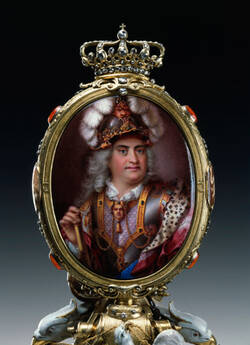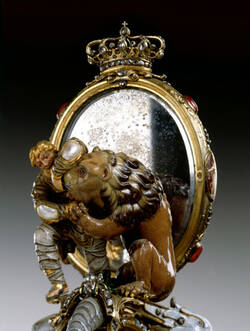This beautiful yellowish-brown bowl – the largest decorative bowl ever created by Johann Melchior Dinglinger – depicts the Labours of Hercules. Dinglinger carved it out of oriental jasper. The carving is very delicate and culminates in a dragon’s head. Above, you see Hercules’ furious struggle with the Nemean lion. The two combatants are standing on an elephant’s trunk which is growing out of the gold foliage and scroll-work.
In this trial of strength, the odds seemed stacked against Hercules. The mighty lion has already ripped his clothing on the arms and back. His naked flesh, represented by pearls, shimmers through. The struggle with the Nemean lion was the first of Hercules’ twelve labours. The others are depicted in the enamelled panels on the edge of the bowl and on the base. When he had triumphed in them all, the hero was eventually rewarded with immortality.
The shaft supporting the bowl is magnificently detailed. Look at the winged dragon there, hanging upside-down, studded with pearls and large emeralds! A large red stone on his back indicates a fatal wound. A green-enamelled serpent entwines itself in his tail. The serpent’s belly is ripped open, and misshapen pearls representing its innards shine through the gash.
With great inventiveness, Dinglinger has managed to unify Hercules’ various labours and link them with August the Strong’s claim to power. For this ornamental bowl is an indirect celebration of the ruler of Saxony and Poland. On the back of the mirror, behind Hercules and the lion, there’s an idealised portrait of the Elector and King. Below, the white eagle of Poland clutches the chain and cross of that country’s highest heraldic order in its claws. Like Hercules confronting the lion, August had to defend his crown against mighty Sweden in the Great Northern War.
Dinglinger spent more than twenty years working on this bowl, and he did so at his own expense. It only came into the possession of August the Strong after the jeweller’s death.
- Material & Technik
- Orientalischer Jaspis, Gold, Silber, vergoldet, Email, Perlen, Diamanten, Smaragde, Rubine
- Abmessungen
- H 60 cm
- Museum
- Grünes Gewölbe
- Ort & Datierung
- Steinschnitt: wohl Augsburg, um 1660 - 1670 / Entwurf und Goldschmiedearbeit: Dresden, wohl zwischen 1708 und 1731
- Inventarnummer
- VIII 304

